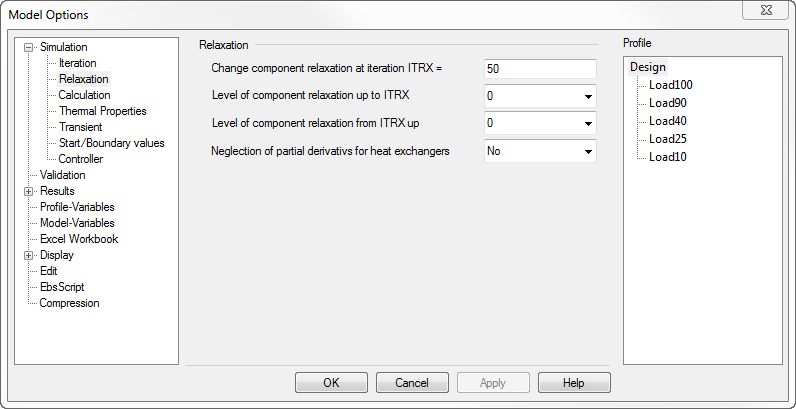


If oscillations occur during the convergence, it is often helpful not to use the solution calculated during the current iteration step as a starting point for the following iteration
step in the iteration, but to use a mix of the current and the previous one. This addition of the old solution is called relaxation. The more of the old solution is added, the stronger
will the relaxation become. This measure does not make sense for models that converge well anyway as it increases the number of required iteration steps. In cases where
convergence problems occur, the convergence behaviour may be improved this way.
Please note that this relaxation applies to all lines in the model. If convergency problems are caused by controllers, you might want to change the local settings at the controller first in order to improve the convergence.
In the field “Change component relaxation at iteration ITRX =” the number of the iteration step is entered, for which the strength of the component-relaxation is switched.
In the combo-box “Level of component relaxation up to ITRX ” the strength of the component relaxation is entered, which is effective for the iteration step 1 to ITRX.
The default value is 0.
In the combo-box “Level of the component relaxation from ITRX up” the strength of the component relaxation is entered, which is effective from the iteration step ITRX till the
end of the iteration. The default value is 0.
As of Release 12 five new intermediate stages have been implemented between Stage 6 and Stage 7, which are now called Stage 7 to 11. The previous Stage 7 has been renamed as Stage 12.
In models previously relaxed in Stage 7 with 0.0001 to 0.0002 are now relaxed with 0.04 to 0.06, which is promising to be successful.
If no convergence can be achieved this way, the stage can be further increased. In the case of Stage 12 the behaviour is then as before.
The share of the new solution in the next iteration step is now in the following ranges for the respective stage: (see Release 12, chapter 1.4.2)
|
Strength of component relaxation |
Description |
Mix ratio for the next iteration |
|
0 |
no relaxation |
1.0 ratio of new solution |
|
1 |
weak |
0.8 - 1.0 ratio of new solution |
|
2 |
low |
0.8 - 1.0 ratio of new solution |
|
3 |
weak to medium |
0.6 - 0.8 ratio of new solution |
|
4 |
medium |
0.4 - 0.6 ratio of new solution |
|
5 |
medium to strong |
0.2 - 0.4 ratio of new solution |
|
6 |
strong |
0.09 - 0.1 ratio of new solution |
|
7 |
very strong |
0.04 - 0.06 ratio of new solution |
|
8 |
very strong |
0.02 - 0.03 ratio of new solution |
|
9 |
very strong |
0.008 - 0.015 ratio of new solution |
|
10 |
very strong |
0.002 - 0.003 ratio of new solution |
|
11 |
very strong |
0.0005 - 0.001 ratio of new solution |
|
12 |
very, very strong |
0.0001 - 0.0002 ratio of new solution |
If the choice box ”Neglection partial derivatives for heat exchangers” has been set to "Yes", the calculation will be carried out from iteration step ITRX to the end neglecting partial derivatives in the equation system for heat exchangers.
This only applies to certain heat exchangers (Components 25-27, 43, 51, 55, 61, 62, 70, 71, 73, 98).
This mode should not be used for the reconciliation as this affects the error propagation.